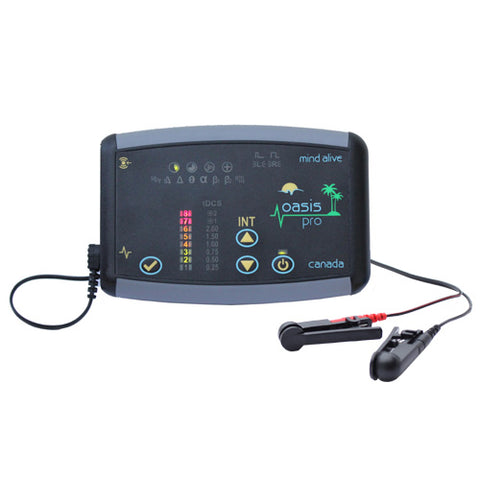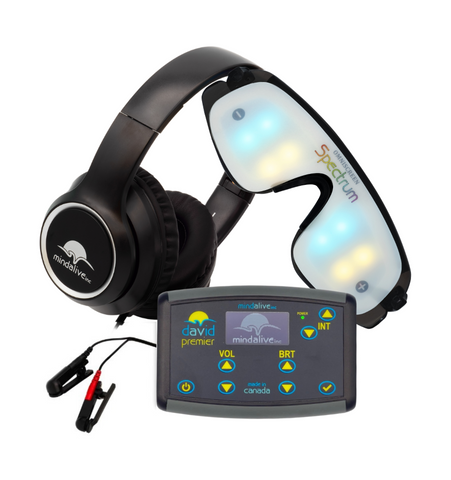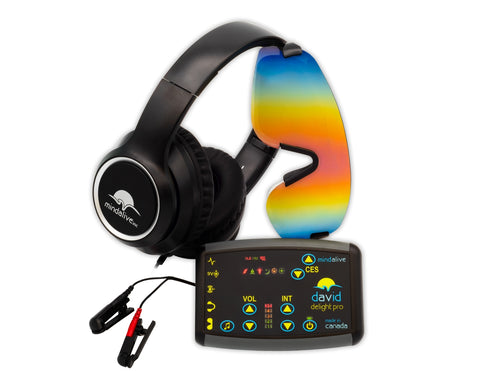
Oasis Pro

- Description
- Includes
- Support
The Oasis Pro is an innovative, high-quality Cranio-Electro Stimulation (CES) device that applies a small pulsed electric current across the head. This small electrical stimulus which is applied laterally across the head promotes good mental health and wellness. The Oasis Pro may be used while you are sitting, lying down, or engaged in quiet, non-hazardous activities
The Oasis Pro uses a rounded pulse instead of a square wave which typically is used in CES stimulation. Unfortunately, square waves sting the ears or body part where the electrodes are attached. By rounding the leading edge of a pulse, over 80% of the sting is removed.
It has been shown that if the frequency of a CES session is randomized, the effect is significantly improved over that of a fixed frequency as randomization reduces habituation. The Oasis Pro offers two types of randomization: phase-shifted randomization and frequency randomization.
The Oasis Pro sessions stimulate within the brain wave range. This makes use of the entrainment effect.
Oasis Pro Session Frequency Range
• Microcurrent Electrical Therapy 0.5 - 3 Hz, short pulses
• Sub-Delta 0.5 - 3 Hz, 50% duty cycle pulses
• Delta 2.5 - 5 Hz
• Theta 6 - 8 Hz
• Alpha 9 - 11 Hz
• Beta 1 12 - 15 Hz
• Beta 2 18 - 22 Hz
• 100 Hz
Each session can be set for 20 minutes, 45 minutes, or three hours.
(gamma sessions below)
About Cranio-Electro Stimulation (CES)
Cranio-Electro Stimulation (CES) was developed in the Soviet Union in the late 1940s to help with sleep problems and has since been used by millions of people all over the world.
Over 200 studies to date have shown that CES increases the calming type of neurotransmitters within the brain, namely serotonin and endorphins. Clinical research over the past 50 years has shown that CES calms the mind, boosts relaxation, helps with sleep, and improves mental sharpness and ability in general. CES is particularly useful in producing calm in situations like being at the dentist, while writing exams or struggling with the fast pace of work or school. CES also settles body discomfort.
About Microcurrent Electro Therapy (MET)
Although electro-medicine has been in existence for well over a thousand years, developments in electronics and new research has seen this technology grow at a terrific rate in recent years. Microcurrent Electro Therapy (MET) is very different than traditional TENS because MET produces its benefits in part on a cellular level. MET has longer-lasting effects than TENS. The concept of MET is based, in part, on Arndt’s Law, which states that weak stimuli excite physiological activity, whereas medium-strength stimuli will encourage it and strong stimuli will suppress it. It is believed that MET delivered at around 500 micro-amps in the 0.5 to 3 Hz range may be most effective for treating aches and discomfort.
About Transcranial DC Stimulation (tDCS)
When a DC current is applied over the scalp with the intention of altering neuronal activity, it is known as transcranial DC stimulation. tDCS is effective in modulating spontaneous neuronal firing. tDCS at intensities of 1 milliamp applied for roughly 20 minutes has been shown to either excite or inhibit the sensorimotor cortex, with the effects lasting over an hour. Excitation is achieved by anodal (+) stimulation, while inhibition is achieved by cathodal (-) stimulation. Anodal stimulation has also been shown to increase both beta and gamma activity in the visual cortex, while cathodal stimulation has decreased beta and gamma activity. Stimulation is generated by putting a wet cloth, cotton ball, or sponge on the scalp over the brain region to be treated and a sponge or cotton ball on the shoulder or the face. The tDCS sessions deliver a maximum intensity of 2.2 milliamps at DC. tDCS is being used to help with many conditions, including improving mood.
The gamma brainwave frequency band is defined as being approximately between 30 to 100 Hz, with 40 Hz being of particular significance, as 40 Hz appears to be the brain’s master clock frequency and other rhythms, especially theta, modulate into 40 Hz. Gamma activity is largely a product of glia cell activity.
Gamma brainwaves help with attention, focus, binding of senses (smell, sight, and hearing), consciousness, mental processing, and perception. The visual system relies heavily on gamma brainwave activity. The ability to recognize novel objects against a background of similar objects is due to gamma activity. So, something as simple as driving a car would be difficult if it were not for gamma. It has been found that gamma activity increases in the brain area related to the task being performed.
Mismatches in gamma/theta modulation, called thalamocortical dysrhythmia, are found to be associated with poor memory, tinnitus, and chronic pain.
The gamma session set is made up of two sessions:
- Gamma β2 20 min
38 – 42 Hz Randomized
2. Gamma β2 3 hrs
38 – 42 Randomized
- Stimulus Cable with Earclips
- Small Carry Bag
- 9-Volt Alkaline Battery - excluding Japan and Australia
- Operator's Manual

